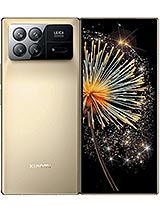The Samsung Galaxy Z fold series has turned into an echelon in the foldable smartphone segment, and thanks to Samsung’s production capacity, the company can compete in pretty much all markets across the globe. But as the market matured, there are some alternatives available if you happen to reside in the right country, which in this case is China.
Many of the Galaxy Z Fold5 direct rivals come from China and are exclusive to the country, like the vivo X Fold2 or the Xiaomi Mix Fold 3. And with the latter being fresh on the shelves, it’s natural for people to ask which one will suit them best.
You can compare the full specs sheets or check our editor’s assessment further below.
Even though the Galaxy Z Fold series has become a synonym for foldable smartphones, the competition is catching up. The Mix Fold 3 has a lot of tricks up its sleeve, and it’s even doing some things better than the Z Fold5. Stick around to find out more.
Size comparison
The Xiaomi Mix Fold 3 definitely has the upper hand in size. While the two weigh just about the same, the Mix Fold 3 has a bigger battery and larger screens. It’s also the thinner of the two, especially when unfolded; the difference is noticeable.
One could argue that in its folded state, the Z Fold5 is the more compact device because it’s narrower and shorter than its rival. Of course, that comes at the expense of the inner screen diagonal, which is 8.03-inch on the unfolded Mix Fold 3, and 7.6-inch on the Z Fold5.
Display comparison
Aside from the diagonal, the Z Fold5 and the Mix Fold 3 have very similar main displays, near-identical, in fact. They are both LTPO and support adaptive refresh rate ranging between 1Hz and 120Hz. Both are foldable, and both have at least HDR10+ certification. The Mix Fold 3, however, has Dolby Vision as well.
Brightness-wise, the two are neck-to-neck, as long as automatic brightness is concerned. In manual mode, the Z Fold5 offers almost 150 nits more. Not that big of a difference, though.
Cover displays
The Galaxy Z Fold5’s cover display is again LTPO, so granular refresh rate control is available and manual brightness is higher. The Mix Fold 3’s cover screen may not be LTPO, but it has Dolby Vision support, just like the internal one. But those two details are minor in light of the considerable difference between the size and aspect ratio of the cover screens of the two phones.
We are great fans of the more natural aspect ratio on the Mix Fold 3’s cover screen. The Z Fold5’s screen quickly starts feeling cramped due to its narrow width. Due to the Mix Fold 3’s incredible slimness, it can almost pull off the feeling of holding a regular non-folding smartphone, albeit a slightly thicker one.
Battery life
Expectedly, the Mix Fold 3 edges out with a longer battery life in both usage scenarios – main display and cover display. The Xiaomi has a slightly bigger battery (4,800 mAh vs. 4,400 mAh), and as a result, it has around 14% longer web browsing runtimes and nearly 19% longer video playback. That’s no trivial difference.
Charging speed
Samsung has never been about charging speeds, so naturally, the Galaxy Z Fold5 falls behind the competition. Although it’s not particularly fast for a 67W-rated device, the Mix Fold 3 still beat the Z Fold5 by a significant margin.
Xiaomi’s foldable takes more than 30 minutes less to charge to 100% and beats the Z Fold5 at the 30-minute mark with a 20% difference.
Additionally, the Mix Fold 3 supports fast 50W wireless charging while the Z Fold5 settles for 15W.
Speaker test
Loudness-wise, the two handsets are near-identical, but the Mix Fold 3 has a clear advantage when it comes to quality. It sounds cleaner and more balanced. Low-frequency sounds are well-pronounced without muting the vocals.
Then again, if you like more bass-heavy and fuller sound in general, the Galaxy Z Fold5 may be your cup of tea.
Performance
Since both handsets run on the same chipset, you can expect near-identical performance, and the benchmark attests to that. There is a clear trend, though, in which the CPU-heavy benchmarks show negligible difference in Z Fold5’s favor.
On the other hand, the Mix Fold 3 scores better in GPU-intensive tasks. Still, in most cases, however, the difference is within the margin of error.
There is more to the story, however, as the hardware on any phone will throttle down, causing a dip in performance when the phone heats up under pressure. And this is where we saw a huge difference between the two devices. When unfolded, the Galaxy Z Fold5’s CPU will throttle down to 73% of its max performance under load, and it will go down to as low as 54% in the same test when closed. At the same time, the Mix Fold 3 couldn’t even finish our CPU throttling test due to overheating regardless of its folded state – a rare sight, indeed.
Besides that, there’s no significant difference in the memory configurations between the two phones. Both start at 12GB/256GB, but the Mix Fold 3 gets 16GB of RAM on its higher tier configurations. The jump to 16GB is hardly justified, though, as 12GB is plenty anyway.
Camera comparison
Many of us were waiting for an update on the Galaxy Z Fold5’s cameras this year, but instead, we got a huge bump in Mix Fold 3’s camera specs. The latter has the clear advantage of Samsung’s foldable as it’s more versatile and a more competent shooter with nicer hardware overall.




Galaxy Z Fold5: 0.5x • 1x • 3x • 5x




Mix Fold 3: 1x • 0.5x • 3.2x • 5x
The Mix Fold 3 not only matches the Z Fold5’s 3x zoom camera but also adds a 5x periscope camera into the well…mix. In the real world, the Mix Fold 3 produces nicer pictures with more detail, better dynamic range, less noise and sharper overall. The difference is rather striking after dusk. You should keep in mind that in the Galaxy Z Fold5’s case, the 5x photos were taken by its 3x camera.




Galaxy Z Fold5: 0.5x • 1x • 3x • 5x




Mix Fold 3: 0.5x • 1x • 3.2x • 5x
The Mix Fold 3 also tends to deliver more conservative photos, color and ambience-wise. The Galaxy, on the other hand, offers more vibrant and eye-pleasing images. The same goes for the video recording.
Although the selfie game of both devices isn’t up to snuff, the Z Fold5 is likely a better choice, depending on the camera you choose to use, of course. The one on the cover screen delivers superior quality compared to the Mix Fold 3 due to its more vibrant colors, sharper and more detailed rendition and somewhat natural skin tone. Dynamic range is also slightly better on the Z Fold5.




Cover screen selfies: Z Fold5 • Z Fold5 • Mix Fold 3 • Mix Fold 3
The inner selfie cam of the Z Fold5 is hard to recommend, though. The 4MP under-display shooter is no match for the Mix Fold 3’s 20MP snapper sitting inside the cutout. The “inner” Galaxy looks blurry and lacks detail, and its image quality is downright disappointing.




Inner screen selfies: Galaxy Z Fold5 • Galaxy Z Fold5 • Mix Fold 3 • Mix Fold 3
Here’s a glimpse of how the Galaxy Z Fold5’s main camera compares in image quality to the Mix Fold 3’s in our Image compare tool.
And here’s how the Galaxy Z Fold5’s main camera compares in video quality to the Mix Fold 3’s in our Video compare tool.
Verdict
If we were to pretend the Mix Fold 3’s availability wasn’t limited to China, we would have recommended it as the winner in this head-to-head in an instant. Xiaomi Mix Fold 3 clearly beat Samsung at its own game here.
While display quality and performance are quite comparable, the Mix Fold 3 impresses with a more competent camera setup, faster charging and better endurance. And while the Galaxy Z Fold5 is more pocket-friendly due to its smaller size, the Mix Fold 3 is one of the thinnest foldables around, and when folded, it really feels like a regular smartphone in hand.
But when we look at realities, if you were to get a gray import of the Mix Fold 3, you’d be left without warranty coverage, and you’d be looking at a Chinese version of MIUI, which would never get proper localization for other countries. Not to mention the lack of Android staples such as Google Pay, Nearby Share, or Android Auto, just to name a few. And you should be comfortable getting handy with some ADB command-line wizardry in order to remove all the unneeded Chinese software and services that come preinstalled.
The Samsung Galaxy Z Fold5 is on the other end of the spectrum regarding software. Not only do you get the most polished foldable experience, but you’d also enjoy a great Android implementation with long software support.
There is much less CPU throttling when under load on the Z Fold5, and you’d be getting the extra peace of mind that the IPX8 rating brings.
- IPX8 water resistance.
- Samsung’s superior software experience for foldables; no tinkering required.
- Full software localization, long support and full international warranty coverage.
- Better performance stability under load.
Get the Galaxy Z Fold5 for:
Samsung US limited-time deal: Get the Galaxy Z Fold5 512GB for the price of 256GB.




